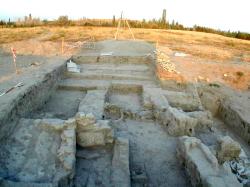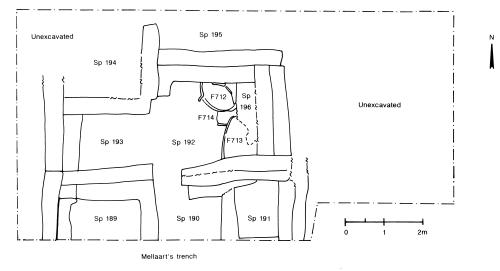The West Mound
From Archive ReportA trench measuring 5 x 11m was opened in July 2000 immediately north of Mellaart痴 Trench 1, situated on the summit of the mound, and a 5-week excavation was carried out by a team of nine British and Turkish archaeologists. Archaeological remains were encountered c. 40 cm below the modern land surface at the northern extent of the trench, rather higher than expected, indicating the possibility of excellent survival of prehistoric deposits not too far down.
The latest use of the mound, other than for agricultural purposes appears to date to the Classical Period, when it was used for burials during Late Roman/Byzantine times. Three graves of this period were excavated within the trench. Two were built of stone within which one contained the badly preserved skeleton of an adult female with a bone spindle and a bronze ring with an incised stone signet while the other held the remains of an adult male without grave goods.
Below the plough soil and Classical Period graves we uncovered the remains of not one, but three or four superimposed building phases. The latest phase walls identified by its white and burnt plaster surfaces was largely destroyed by its proximity to the surface and therefore ploughing activity. The second building phase consists of a large open area running east-west opening into the central room of a range of three small rooms along the south. The earliest building phase excavated so far was the one found in 1998, and this has only been reached in the three small rooms to the south (spaces 189-191, Figure 11 and Figure 12) |
 Figure 11: West Mound excavations, looking east. In the foreground are Spaces 194, 193 and 189 |

Figure 12: West Mound Plan 2000
There is a noticeable change in material culture compared to the earlier Neolithic East Mound, especially in the pottery. On the floor of the western part of the main room was a unique square plaster bowl containing burnt material (Figure 22). The exterior is painted with geometric designs in red and black. Bichrome decoration has not been found on the pottery so far, nor is the design similar to the painted pottery. However, it does resemble some of the geometric wall-paintings found on the Neolithic East Mound, and the shape of the plaster bowl has similarities to a square or oblong pottery bowl found in the upper layers of the West Mound this year.
Dating of the West Mound is uncertain, and it is of particular interest to find out whether settlement moved directly from the East to the West Mound, or whether there was a break in occupation. To assist in this dating debate a number of core samples were taken, including a 5.2 m core, started at the base of the Mellaart trench and reached natural. Seven samples were also taken for carbon dating, and this should enable us to get a clearer idea of settlement continuity at Çatalhöyük